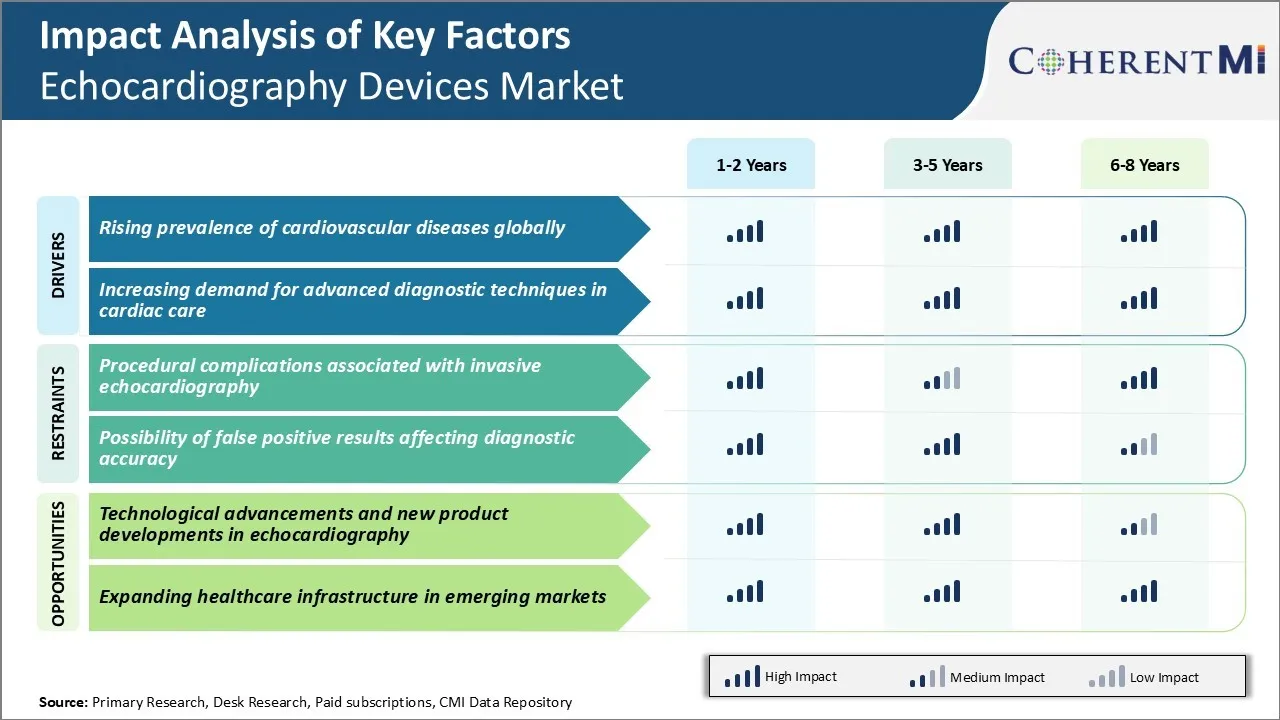Echocardiography Devices Market Trends
Market Driver - Rising Prevalence of Cardiovascular Diseases Globally
A number of epidemiological studies have shown that cardiovascular diseases now account for over 30% of all deaths globally each year. If seen regionally, developed regions such as North America and Europe have historically witnessed a higher rate of cardiovascular patient pool due to aged population and lifestyle factors.
However, the developing parts of the world including Asia Pacific and Latin America are also experiencing a rapid rise in cardiovascular patient population driven by increasing life expectancy, growing adoption of unhealthy lifestyle and lack of awareness.
This substantial increase in cardiovascular patient volume has put immense pressure on the healthcare systems worldwide. There has been a growing need for advanced and non-invasive diagnostic modalities to efficiently diagnose and manage the cardiovascular conditions.
As echocardiography helps in early detection and better management of cardiovascular diseases, the growing prevalence of such diseases has directly contributed to higher demand for echocardiography devices across various healthcare settings.
With limited cardiologists and long wait times for tests, the role of echocardiography in triaging, diagnosis and monitoring cardiovascular patients has become more crucial than ever before. This has significantly driven the adoption of echocardiography devices globally.
Market Driver - Increasing Demand for Advanced Diagnostic Techniques in Cardiac Care
Healthcare providers and doctors have been continuously striving to identify advanced diagnostic solutions that can improve patient care, raise efficiency and lower healthcare costs. In the area of cardiology as well, there remains a strong emphasis on leveraging latest technologies for non-invasive evaluation of heart conditions. Factors like ageing population susceptible to cardiovascular problems, shorter hospital stays pushing demand for fast diagnosis, stringent reimbursement policies favoring outpatient care over hospitalization have all created favorable environment for newer cardiac diagnostic modalities.
Echocardiogram as a cardiac imaging technology has witnessed tremendous improvements over the years. Introduction of enhanced visualization techniques, automated analysis features, portable devices, stress-echo capabilities etc. have expanded clinical applications of echocardiography from basic morphologic assessment to sophisticated functional evaluation of heart mechanics. Advancements have enabled early and accurate diagnosis of conditions that were previously difficult to detect. This has found widespread acceptance among cardiologists and led to echocardiography replacing alternative tests in certain clinical scenarios.
Growing confidence in echocardiography driven diagnostic outcomes has augmented its demand across various hospital departments as well as physician offices. Moreover, factors such as favorable reimbursement for echocardiography, emphasis on preventive healthcare are contributing to the surging demand for advanced echocardiography systems and probes.

Market Challenge - Procedural Complications Associated with Invasive Echocardiography
One of the major challenges currently faced by the echocardiography devices market is the procedural complications associated with invasive echocardiography such as transesophageal echocardiography (TEE) and intracardiac echocardiography (ICE). Invasive echocardiographic procedures require the insertion of probes into the esophagus or through blood vessels into the heart which makes them more complex and riskier compared to conventional transthoracic echocardiography (TTE).
Some common complications of TEE include bleeding, infection, arrhythmias, and esophageal injury while ICE procedures carry risks of vessel damage, thrombosis and embolism. The possibility of such adverse events often discourages clinicians from recommending and patients from opting for invasive methods when conventional TTE is sufficient. This limits the uptake of advanced echocardiography technologies even in cases where they offer significant diagnostic advantages over external ultrasound imaging.
Addressing the safety concerns around invasive procedures through reduction of complication rates and development of minimally invasive techniques is thus a major challenge that needs to be overcome to boost the market potential of echocardiography devices.
Market Opportunity - Technological Advancements and New Product Developments in Echocardiography
The echocardiography devices market is presenting substantial opportunities for growth driven by ongoing technological advancements and new product developments in the field. Manufacturers are innovating novel echocardiography platforms integrating advanced ultrasound imaging technologies such as three-dimensional (3D), four-dimensional (4D) and transesophageal echocardiography (TEE). These new systems provide clinicians with clearer and more detailed dynamic images of the heart enabling more accurate diagnoses.
Simultaneously, industry players are also coming up with smaller and more flexible probes making procedures less invasive. The development of intracardiac echocardiography (ICE) systems has further expanded the clinical applications of echocardiography. Moreover, integration of artificial intelligence (AI) solutions for echocardiography imaging analysis and reporting is anticipated to revolutionize cardiac ultrasound procedures. Continued technological upgrades expanding the clinical utility of echocardiography thus present lucrative avenues for revenue growth in the coming years.